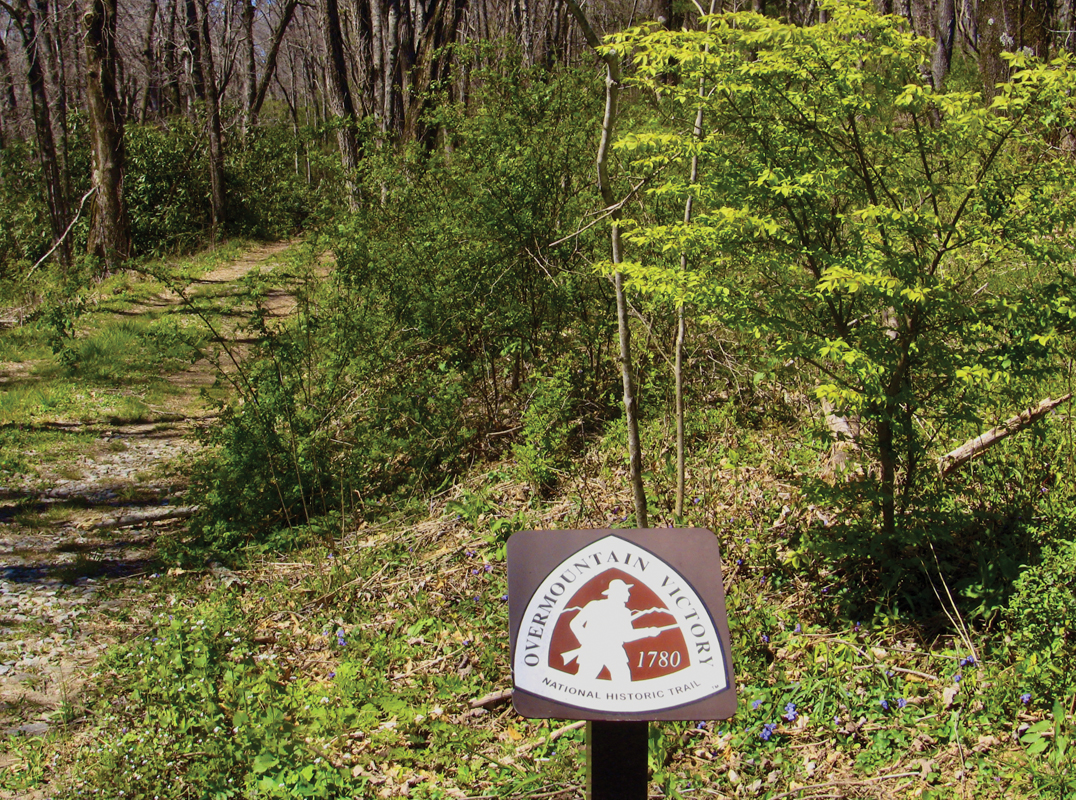Overmountain Victory National Historic Trail
Overmountain Victory National Historic Trail

History
Western North Carolina’s landmark national parks reveal their American significance in remarkably rich and multifaceted ways. Diversity plays a role. Case in point: “national trails” aren’t all the same. Unlike the Appalachian “National Scenic Trail,” the Overmountain Victory Trail (and the Trail of Tears) are both officially “National Historic Trails.”
But that said, the Overmountain Victory Trail (OVT) is far more than the story of a single battle, even one as significant as the 1780 Battle of Kings Mountain. Like the Smokies and Parkway, both in the top tier for national significance, the Overmountain Victory Trail is nevertheless the entry point to an even bigger realm—understanding how the remarkably little-known, underappreciated Southern Campaign of the American Revolution actually won the war.
That story starts around 1780, when military action in New England had stalemated, and George Washington was about to send his favorite general, Nathanael Greene, south to shake things up. The shaking started when settlers moving deeper into the backcountry to avoid British influence found themselves beyond the mountains, in violation of Britain’s western limit of settlement.
Southern commander Lord Cornwallis ordered an army of Loyalists under his left flank commander, Scottish Major Patrick Ferguson, to punish these “Overmountain” rebels. Ferguson threatened their leaders with, “fire and sword,” but before he could act, the patriots got him first. A multi-pronged militia march trapped him on October 7, 1780 atop a rocky, 980-foot summit called Kings Mountain, found just inside South Carolina.
This was not a battle between formal lines of professional soldiers, with Red Coats versus Continental Army blue and buff. Holding the high ground, the Loyalists overshot the swarming sharp shooters below, firing from behind trees. Ferguson was killed and his Loyalists scattered.
Kings Mountain was the first domino to fall, but it would require more conventional American battle tactics and another six months of victories before “the fighting Quaker” Nathanael Greene would send Cornwallis into Washington’s arms and defeat at Yorktown. The Overmountain Victory Trail is a perfect introduction to that nation-building narrative.
The next domino fell at the battle of Cowpens (near Kings Mountain) in January 1781. General Daniel Morgan’s Continental Army experience helped him devise the strategy that finally made effective use of unreliable militia. He begged his men to stand long enough to fire two deadly volleys before fleeing to protection behind the bayonets of battle-hardened Continentals and the cavalry of Lieutenant Colonel William Washington (George Washington’s second cousin). Jefferson called the battle, “the turn of the tide of success.”
The strategy worked. Morgan’s army reunited with General Greene, and for the next two months, Greene eluded Cornwallis before choosing to stop and fight the British in Greensboro at today’s Guilford Courthouse National Military Park. Greene adopted Morgan’s use of the militia, and though Greene withdrew, the British Army was so decimated that it abandoned the Carolinas for the fateful destination of Yorktown.
As the bicentennial of the 1780 Battle of Kings Mountain neared in 1980, many citizens walked portions of the routes followed by patriot militia in four states. Later, federal legislation joined these one-time paths into the commemorative Overmountain Victory National Historic Trail, and September and October.

The sign attests that the path ahead is a genuine, colonial-era road that the militia traveled on.
Why Visit
A start on the OVT makes it easy to appreciate the decisive role our region played in the American Revolution. The route of victorious militias is a tourism corridor of great scenery and historic sites, including the three battlefields above, two of which (Kings Mountain and Cowpens) are side-by-side, not far from The Carl Sandburg Home National Historic Site. The Overmountain Victory Trail National Park Service website lists extensive destinations along the entire trail.
Luckily, our view of the Southern campaign is getting better as a wealth of other little-known sites become more widely appreciated, or even better preserved. The American Battlefield Trust’s newly-inaugurated Liberty Trail leads to a variety of battlefields where recently-acquired land is improving public access in North Carolina and South Carolina.
Another plus—the OVT is a trail you don’t have to hike. The 330-mile motor route follows highways in North and South Carolina, Tennessee, and Virginia (with 87 miles of trail tread sections for hiking and easy mountain biking). The routes honor the multiple long marches of militia that converged to win at Kings Mountain. Best of all, the routes are increasingly formalized. The three northern prongs of the route lead south from historic militia mustering grounds—a number of them historic sites, like McDowell House at Quaker Meadows in Morganton.
A fascinating footnote to the western part of this march: from Tennessee, the militia crossed the crest of the Roan Highlands into North Carolina, “in shoe mouth deep,” September snow at Yellow Mountain Gap—150 years before the Appalachian Trail was built there. It’s likely the highest elevation military action of the Revolutionary War, and still a popular history day hike on the AT. Sycamore Shoals State Historic Park in Elizabethton, the militia mustering ground, is a must-see site.
Living history
Boone’s summer outdoor drama Horn in the West actually adopts a version of the Overmountain Victory Trail story. The adjacent Hickory Ridge Living History Museum offers historic structures, costumed period interpreters, musket firings, and more.
Take the Trail
W. Kerr Scott Reservoir, Wilkesboro: Easy, mountain-bikeable flow portion of OVT that includes a lakeshore ride and a paved greenway, too.
Lake James State Park, Marion: Moderate mountain bike routes and hiking trails including a designated stretch of the MST itself.
Learn more
The Overmountain Victory Trail Association is a nonprofit group dedicated to preserving and protecting the historic route to King’s Mountain. ovta.org